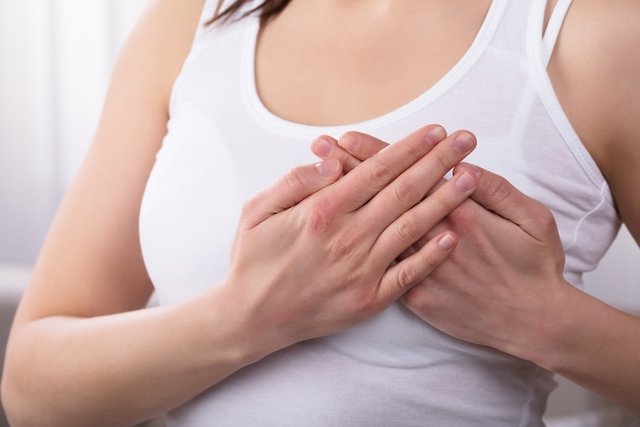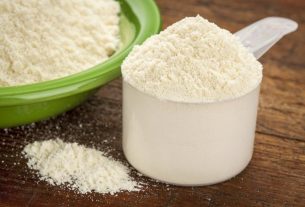Breast pain can be caused by hormonal changes, such as those that occur during menstruation, menopause or pregnancy, be a consequence of taking medication or changing contraceptives, or be a sign of a cyst in the breast, fibroadenoma or intraductal papilloma, for example.
In general, breast pain is mild and occurs periodically, improving after a few days. However, depending on the cause, it is possible to notice some symptoms, such as discharge from the nipple, local redness and a burning sensation, for example.
Therefore, if pain or discomfort in the breast persists for more than 15 days or if it appears to be unrelated to menstruation or menopause, it is recommended to consult a breast specialist or gynecologist to identify the cause and begin the most appropriate treatment.

Main causes
The most common causes of breast pain are:
1. Onset of puberty
Girls between the ages of 10 and 14, who are entering puberty, may experience minor pain or discomfort in their breasts, which are beginning to grow and become more painful.
What to do: No specific treatment is necessary, but bathing in warm water can relieve discomfort. At this stage it is also important to wear a bra that provides good support for your breast size.
2. PMS or menstruation
Before and during menstruation, hormonal changes can cause breast pain in some women, although it is not serious, although it is uncomfortable every month. In these cases, the woman may feel small stitches in the breast or increased sensitivity, even in the nipple. When the pain is mild or moderate and lasts 1 to 4 days, it is considered normal, but when it lasts more than 10 days and radiates to the arm or armpit, it should be evaluated by a gynecologist or mastologist.
What to do: It is rarely necessary to take medication, but continued use of the contraceptive pill can help alleviate symptoms with each period. When the pain is very bothersome, the gynecologist may recommend taking Bromocriptine, Danazol and Tamoxifen, or as natural options, the Chaste Lamb Evening primrose oil, or vitamin E, which must be taken for 3 months to then evaluate the results.
3. Menopause
Some women when they are entering menopause may experience sore breasts or a burning sensation, in addition to other typical symptoms of menopause, such as hot flashes, night sweats and mood changes, for example.
Breast pain occurs due to changes in the levels of the hormones estrogen and progesterone, which tend to vary greatly during the first phase of menopause, affecting the breast tissue and causing discomfort.
What to do: No specific treatment is necessary, but wearing a bra with good support, reducing the amount of caffeine and applying warm compresses to the breasts are simple strategies that can reduce pain.
4. Pregnancy
Breasts can be especially sensitive at the beginning and end of pregnancy, due to the growth of the mammary glands and the production of breast milk, for example. If you suspect you may be pregnant, check out the 10 first symptoms of pregnancy.
What to do: Applying warm compresses can help alleviate discomfort, as can taking a bath with warm water and lightly massaging the area. During pregnancy, it is also recommended to wear a nursing bra for better breast support.
5. Breastfeeding
During breastfeeding, when the breasts are full of milk, the breasts can become hard and very painful, but if the pain is sharp and localized in the nipple, this may indicate a crack, which causes intense pain and even bleeding.
What to do: If the breast is full of milk, the best strategy is to breastfeed or express the milk with a pump. If the nipples are sore, you should take a good look at the area to check whether there is a blocked duct or crack at the site of the pain, which prevents the passage of milk and could cause mastitis, which is a more serious situation. Therefore, if you have problems with breastfeeding, the nurse specialist in obstetrics will be able to personally indicate what to do to solve this problem. Learn how to solve this and other common breastfeeding problems.
6. Use of medicines
Taking certain medications, such as Aldomet, Aldactone, Digoxin, Anadrol and Chlorpromazine, has the side effect of breast pain.
What to do: The doctor must be informed about the appearance of this symptom and its intensity. The doctor may check whether it is possible to recommend taking another medication that does not cause breast tenderness.
7. Cyst on mom
Some women have irregular breast tissue called fibrocystic breasts, which can cause pain especially before menstruation. This type of problem is not linked to cancer, but it also causes the formation of lumps in the breasts that can grow or disappear on their own.
What to do: In cases where the pain is not related to menstruation, medications such as Tylenol, Aspirin or Ibuprofen can be used under medical advice. Find out how breast cysts are treated.
8. Changing contraceptives
When starting to take or changing contraceptives, breast pain may appear, which can be mild or moderate and generally affects both breasts at the same time, and there may also be a burning sensation.
What to do: Massage while bathing and wearing a comfortable bra can be a good solution while the body does not adapt to the contraceptive pill, which can take 2 to 3 months.
9. After surgery
After surgery in the pectoral region, pain in the breasts may result, especially in the first few days after the surgical procedure, due to skin tension and the renewal of breast tissue.
What to do: If the pain is very intense in the first few days or appears a few weeks after surgery, it is recommended that a doctor be consulted so that a clinical evaluation can be carried out and the cause can be identified in order to begin the most appropriate treatment.
10. Breast fibroadenoma
Breast fibroadenoma is the most common benign breast tumor and appears between 20 and 40 years of age, and is characterized by being a well-defined ball in the breast, which can move and cause pain.
What to do: It is recommended to consult a gynecologist or mastologist for a breast ultrasound or mammogram to confirm the diagnosis and begin treatment, which is normally done with surgery.
11. Intraductal papilloma
Intraductal papilloma is the growth of a benign tumor in the breast ducts, causing bloody secretion that comes out of the nipple, as well as pain and a feeling of a lump in the breast, being more common in women between 30 and 50 years old.
What to do: It is important that the gynecologist or mastologist is consulted so that tests can be indicated to confirm the diagnosis and, thus, it is possible to perform surgery to remove the papilloma.
Could breast pain be a sign of cancer?
Breast pain is rarely a sign of cancer, as malignant tumors generally do not cause pain. In the case of breast cancer, other symptoms may be present such as discharge from the nipple, depression in a part of the breast. Check out the 12 symptoms of breast cancer.
The women most at risk of having breast cancer are those who have a mother or grandmother with breast cancer, who are over 45 years of age, and those who have already had some type of cancer. Young women who breastfed and who only had benign lesions or even benign cysts in the breast are no longer at risk of breast cancer.
In any case, in case of suspicion, you should go to the gynecologist to investigate and perform a mammogram from the age of 40.
When to go to the doctor
You should see a doctor when chest pain is severe or lasts more than 10 consecutive days, or if it appears along with symptoms such as:
- Clear or bloody discharge from the nipple;
- Redness or pus in the breast;
- Fever;
- The appearance of a lump in the breast that disappears after the menstrual period.
In case of symptoms, make an appointment with the nearest mastologist or gynecologist for a general assessment:
Taking care of your health has never been easier!
Furthermore, it is important to go to the gynecologist at least once a year for exams to assess the health of the breast and reproductive system, preventing problems and identifying diseases early on.
The doctor normally evaluates the breasts by observing the location of the pain, whether there are changes such as asymmetry or retraction of the breast at any point, and also looks for inflamed or painful areas in the armpits or collarbones, to check whether there is a need to request tests such as a mammogram, ultrasound or ultrasound of the breast, especially if there are cases of breast cancer in the family.

Sign up for our newsletter and stay up to date with exclusive news
that can transform your routine!
Warning: Undefined array key "title" in /home/storelat/public_html/wp-content/plugins/link-whisper-premium/templates/frontend/related-posts.php on line 12
Warning: Undefined array key "title_tag" in /home/storelat/public_html/wp-content/plugins/link-whisper-premium/templates/frontend/related-posts.php on line 13



